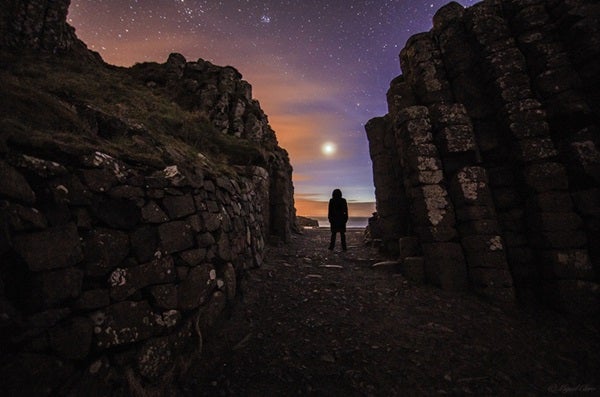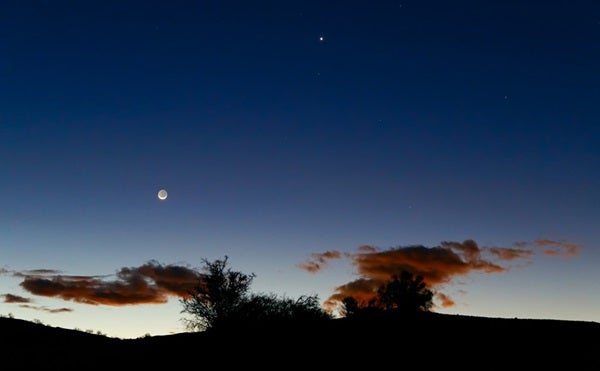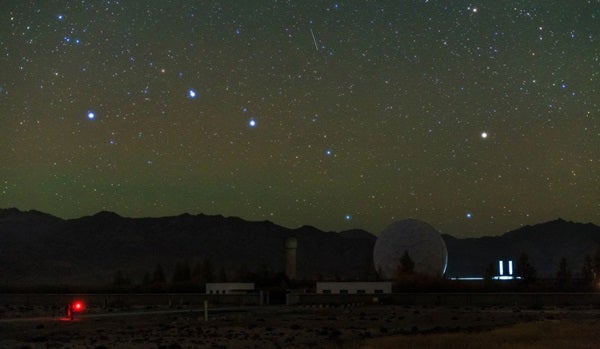A lone bright star now hangs low in the south during the early evening hours. First-magnitude Fomalhaut — often called “the Solitary One” — belongs to the constellation Piscis Austrinus the Southern Fish. From mid-northern latitudes, it climbs 20° above the horizon at its best. How solitary is Fomalhaut? The nearest 1st-magnitude star to it, Achernar at the southern end of Eridanus the River, lies some 40° away. It doesn’t appear quite as isolated as normal this year, however, because magnitude –0.1 Mars stands about 20° north of it.
Saturday, December 1
Venus appears brilliant from the time it rises a little before 4 a.m. local time until close to sunrise some three hours later. It stands about 25° above the southeastern horizon an hour before the Sun comes up. Shining at magnitude –4.9, it appears slightly brighter today than at any other time during this morning apparition. (The difference is essentially imperceptible, however — it appears less than 0.01 magnitude brighter today than it did yesterday or will tomorrow.) When viewed through a telescope this morning, Venus spans 40″ and appears one-quarter lit.
Sunday, December 2
The variable star Algol in Perseus reaches minimum brightness at 9:53 p.m. EST, when it shines at magnitude 3.4. If you start watching it after darkness falls this evening, you can see it more than triple in brightness, to magnitude 2.1, over the course of a few hours. This eclipsing binary star runs through a cycle from minimum to maximum and back every 2.87 days. Algol appears high in the northeast after sunset and passes nearly overhead around 10:30 p.m. local time.
Dazzling Venus continues to dominate the morning sky, but it has some impressive, if temporary, company today. A slender crescent Moon hangs 5° above the planet, and the two will make a splendid sight with naked eyes or through binoculars. Look more closely and you also should pick up 1st-magnitude Spica — Virgo the Maiden’s brightest star — 7° to the right of the pair.
Tuesday, December 4
The Geminid meteor shower gets underway tonight. Although the shower won’t peak until the night of December 13/14, you should start to see a few Geminids during the overnight hours. And with the Moon showing only a slim crescent phase this week, conditions could hardly be better for a sneak peek at what is arguably the best annual meteor shower. To tell a Geminid meteor from a random dust particle burning up in Earth’s atmosphere, trace the streak of light’s path backward. A shower meteor will appear to originate from the constellation Gemini the Twins.
Wednesday, December 5
Although Mercury passed between the Sun and Earth just last week, the innermost planet has already climbed into view during morning twilight. Look low in the southeast about 30 minutes before sunrise, when Mercury stands nearly 9° above the horizon. The planet shines at magnitude 0.7, so you’ll likely need binoculars to pick it out of the twilight this morning. Binoculars also will show a waning crescent Moon hanging 5° above the planet. When viewed through a telescope, Mercury appears 9″ across and sports a slender crescent phase. The inner world will grow brighter and climb higher as it approaches greatest elongation in mid-December.
Thursday, December 6
Mars continues to put on a nice show these December evenings. The Red Planet appears nearly halfway to the zenith in the southern sky as twilight fades to darkness. The ruddy world shines at magnitude 0.1, as bright as any other early evening object, against the faint backdrop of Aquarius the Water-bearer. As you gaze at Mars with your naked eye, you might assume it’s the only object of interest in the area. But target the planet through binoculars or a telescope and you’ll also see the much fainter glow of Neptune. The magnitude 7.9 ice giant lies 23′ east-northeast of Mars this evening. The two switch positions tomorrow night, with Neptune 16′ southwest of Mars. (The magnitude 6.1 star 81 Aquarii then stands 12′ north of Mars.) The actual conjunction between the two planets occurs at 9:08 a.m. EST on the 7th, when Mars passes 2.2′ north of Neptune, but both objects then lie below the horizon from North America. When viewed through a telescope, Mars appears 9″ while Neptune spans 2.3″. The two planets won’t pass closer to each other under a dark sky until October 19, 2210.
Friday, December 7
Although people in the Northern Hemisphere won’t experience the shortest day of the year for another two weeks (at the winter solstice December 21), those at 40° north latitude will see the Sun set earlier today than at any other time this year. Tomorrow’s sunset will arrive about one second later than today’s. The date of earliest sunset depends on latitude — the farther north you live, the closer it occurs to the solstice.
New Moon occurs at 2:20 a.m. EST. At its new phase, the Moon crosses the sky with the Sun and so remains hidden in our star’s glare.
Saturday, December 8
The days of viewing Saturn in the evening sky are just about over. In fact, tonight might be your last, best chance to see it this year. Although the magnitude 0.5 ringed world stands only 7° high in the southwest 45 minutes after sunset, a slender, two-day-old Moon serves as a guide. The two objects lie 3° apart and look beautiful through binoculars.
Head outside in early evening this week and you can see the Big Dipper scraping the northern horizon. For latitudes north of about 40°, this conspicuous asterism never sets (“circumpolar” in astronomical parlance), though December evenings find it at its lowest ebb. This means that the constellation on the opposite side of the North Celestial Pole, the familiar W-shaped Cassiopeia, currently rides highest in the sky.












